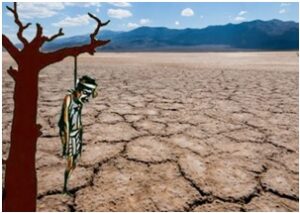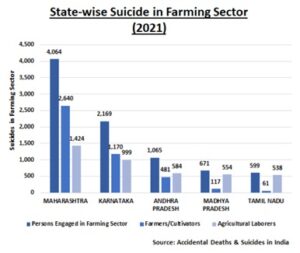Alarming Rise in Farmer Suicides in Marathwada Region in 2023
Relevance
- GS Paper 3 Agricultural produce and issues and related constraints; e-technology in the aid of farmers.Inclusive growth and issues arising from it.
- Tags: #indianeconomy #challenges #growth #currentaffairs #upsc.
Why in the News?
It is founded that 685 farmer suicides happened in Marathwada so far in 2023
India, primarily an agrarian nation, relies heavily on agriculture, with nearly 70% of its population directly or indirectly dependent on this sector for their livelihoods. Despite this deep-rooted agricultural tradition, a deeply concerning issue has emerged in recent years: the rising number of farmer suicides.
According to data from the Central Government, despite implementing a multi-faceted strategy aimed at improving farmers’ income and social security, a distressing trend persists. Since 2013, India has witnessed over 12,000 suicides annually within the agricultural sector. Shockingly, this farmer suicides account for approximately 10% of all suicides recorded across the nation. This grim reality highlights the urgent need for comprehensive intervention and support for those who bear the weight of India’s agricultural
Disturbing Statistics
- In the year 2023, a distressing number of farmers in Maharashtra’s Marathwada region have taken their own lives, totaling 685 cases.
- This grim statistic covers the period from January 1 to August 31. Of particular concern, 294 of these tragic deaths occurred during the three monsoon months (June to August).
Beed District Takes the Lead
- The district most deeply affected by this crisis is Beed, the home district of the state’s Agriculture Minister, Dhananjay Munde.
- An astonishing 186 farmer suicides were reported in Beed alone during this period, making it the epicenter of this tragic phenomenon.
Marathwada’s Agonizing Plight and Rainfall Deficit
Marathwada’s Ongoing Struggle
- Marathwada, a parched region located in central Maharashtra, comprises eight districts: Aurangabad, Jalna, Beed, Parbhani, Nanded, Osmanabad, Hingoli, and Latur. These districts are currently grappling with the harrowing issue of farmer suicides.
Rainfall Deficiency Worsens the Crisis
- Adding to the woes, Marathwada is facing a severe rainfall deficit, with only 20.7% of the average monsoon showers received thus far.
- As of September 11, the region has received a mere 455.4 mm of rainfall, significantly lower than the average of 574.4 mm for the same period.
District-wise Breakdown of Tragedy
- Beyond Beed, the breakdown of farmer suicides in the other Marathwada districts is as follows: Osmanabad (113), Nanded (110), Aurangabad (95), Parbhani (58), Latur (51), Jalna (50), and Hingoli (22). This heartbreaking data underscores the scale and severity of the crisis.
Causes of Farmer Suicides in India
- Rising Input Costs: Agricultural input expenses, including seeds, fertilizers, and pesticides, have surged, straining farmers’ finances.
- Equipment Expenses: The cost of farming equipment, like tractors and pumps, adds to financial pressures.
- Labor Cost Burden: Hiring labor and animals has become costlier, exacerbated by schemes like MGNREGA and increased minimum basic income.
- Loan Distress: A significant portion of farmer suicides is linked to unpaid bank loans, while moneylender loans play a smaller role.
- Market Integration Challenges: Despite initiatives like e-National Agricultural Market (eNAM), reducing intermediaries remains a complex task.
- Awareness Gap: Many farmers, especially smallholders, lack awareness of government schemes due to the digital divide and limited literacy.
- Water Crisis Impact: Regions like Maharashtra and Karnataka, facing water scarcity, witness more farmer suicides, worsened by poor monsoons and water disputes.
- Climate Change: Unpredictable weather patterns, floods, and crop losses due to climate change disrupt farming.
- Economic Policies: Urban-centric economic policies and price controls limit farmers’ profits, perpetuating debt cycles.
- Loan Waivers: Government loan waivers, while popular, may not address the root causes of farmer distress; reinvestment and restructuring are essential for sector improvement.
Addressing Farmer Suicides – A Path Forward
- Reducing Dependence on Nature: Lessening agriculture’s reliance on unpredictable natural factors by implementing effective water management techniques.
- Preventing Crop Failure: The government should prioritize strategies to prevent crop failures through measures such as improved farming practices and resilient crop varieties.
- Inclusive Access to Institutional Finance: Ensuring that every farmer, especially those in need, has access to institutional finance. Streamlining the process and vigilant monitoring to prevent misuse where large landowners might be the actual beneficiaries.
- Economic Counseling: Providing timely and effective economic counseling to farmers to enhance their cultivation methods and financial management.
- Technology for All: Ensuring that technological advancements in agriculture are accessible to small and impoverished farmers to increase productivity.
- Land Consolidation: Exploring options to consolidate small farmers’ land holdings into economically viable plots.
- Diversifying Income Sources: Advising small farmers on alternative income sources and offering training to facilitate their adoption.
- Sustainable Relief Measures: Shifting the focus from mere relief to sustainable livelihoods for farmers’ families. Avoiding situations where farmers resort to suicide in the hope of securing relief packages, as seen in certain cases in Andhra Pradesh.
Addressing the challenges faced by farmers requires a multifaceted approach. The government, in collaboration with diverse stakeholders, must devise comprehensive and enduring strategies to alleviate farmer indebtedness, enhance crop yields, optimize water resource management, and create alternative income opportunities for farmers.
Sources: The new Indian Express
Mains Question
Discuss the multifaceted factors contributing to the alarming rate of farmer suicides in India with focus on marathawada and propose a comprehensive policy framework to address this critical issue, taking into consideration both immediate relief and long-term sustainable solutions. 250words.





